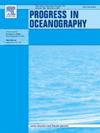生物地球化学观测对模拟海洋生态系统指标的控制
IF 3.6
3区 地球科学
Q1 OCEANOGRAPHY
引用次数: 0
摘要
为了保护受气候变化和人为压力源威胁的海洋生态系统,必须对海洋健康指标进行业务监测。这些指标综合了与操作服务用户相关的多个海上流程。在这项研究中,我们通过使用一种新提出的方法框架,评估了由操作模型模拟的选定海洋指标是否可以有效地受到生物地球化学观测的约束(即控制)。该方法首先根据可观测变量的初始条件筛选指标的敏感性。这些初始条件是随机摄动在蒙特卡罗模拟的一维构型的多模式系。然后,将模型应用于三维综同化实验,综方差的减小证实了观测指标的可控性。该方法应用于10个相关的生态系统指标(从无机化学品到浮游生物生产),7种观测类型(来自卫星和水下平台的数据),以及5种不同复杂程度的生物地球化学模型的集合,这些模型由欧洲哥白尼海洋服务中心实际使用。我们的结果表明,所有的指标是由一个或多个类型的观测控制。特别是,浮游植物物候指标通过海洋表面颜色和叶绿素剖面的合并观测得到控制和改进。类似的观测也控制和减少了浮游生物群落结构和生产的不确定性。然而,当叶绿素-a数据被同化时,营养效率和颗粒有机碳(POC)的不确定性增加。这可能反映了模型技能的降低,尽管相关观察结果的缺乏阻碍了结论性评估。我们建议此处提出的可控性评估成为设计运行监测、再分析和预报系统的标准做法。这种标准化将为业务服务的用户提供更准确和精确的海洋生态系统指标估计。本文章由计算机程序翻译,如有差异,请以英文原文为准。
Control of simulated ocean ecosystem indicators by biogeochemical observations
To protect marine ecosystems threatened by climate change and anthropic stressors, it is essential to operationally monitor ocean health indicators. These are metrics synthetizing multiple marine processes relevant to the users of operational services. In this study, we assess whether selected ocean indicators simulated by operational models can be effectively constrained (i.e., controlled) by biogeochemical observations, by using a newly proposed methodological framework. The method consists in firstly screening the sensitivities of the indicators with respect to the initial conditions of the observable variables. These initial conditions are perturbed stochastically in Monte Carlo simulations of one-dimensional configurations of a multi-model ensemble. Then, the models are applied in three-dimensional ensemble assimilation experiments, where the reduction of the ensemble variance corroborates the controllability of the indicators by the observations. The method is applied to ten relevant ecosystem indicators (ranging from inorganic chemicals to plankton production), seven observation types (representing data from satellite and underwater platforms), and an ensemble of five biogeochemical models of different complexity, employed operationally by the European Copernicus Marine Service. Our results demonstrate that all the indicators are controlled by one or more types of observations. In particular, the indicators of phytoplankton phenology are controlled and improved by merged observations of surface ocean colour and chlorophyll profiles. Similar observations also control and reduce the uncertainty of the plankton community structure and production. However, we observe that the uncertainty of trophic efficiency and particulate organic carbon (POC) increases when chlorophyll-a data are assimilated. This may reflect reduced model skill, though the unavailability of relevant observations prevents a conclusive assessment. We recommend that the controllability assessment proposed here becomes a standard practice in the design of operational monitoring, reanalysis, and forecast systems. Such standardization would provide users of operational services with more accurate and precise estimates of ocean ecosystem indicators.
求助全文
通过发布文献求助,成功后即可免费获取论文全文。
去求助
来源期刊

Progress in Oceanography
地学-海洋学
CiteScore
7.20
自引率
4.90%
发文量
138
审稿时长
3 months
期刊介绍:
Progress in Oceanography publishes the longer, more comprehensive papers that most oceanographers feel are necessary, on occasion, to do justice to their work. Contributions are generally either a review of an aspect of oceanography or a treatise on an expanding oceanographic subject. The articles cover the entire spectrum of disciplines within the science of oceanography. Occasionally volumes are devoted to collections of papers and conference proceedings of exceptional interest. Essential reading for all oceanographers.
 求助内容:
求助内容: 应助结果提醒方式:
应助结果提醒方式:


